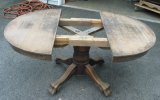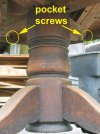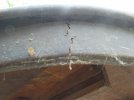Hi NC woodworkers,
I’m refinishing an Amish style oak pedestal table. It’s 48” round and extendable.
The apron is bent wood lamination, peeling in spots from dings. 43” interior diameter. It’s also scalloped and has some scrollwork. I’d prefer to replace it with a plain wood apron with none of those embellishments. I can’t do without an apron since the mechanism of the extender needs to be concealed.
Can anyone please point me to a source for bent wood pieces? Oak to match would be great, but really I can’t be picky. It would be fine if it came in quarters instead of halves. I called these folks because this seems to be the exact table, but they can’t source parts:

 www.deutschfurniturehaus.com
www.deutschfurniturehaus.com
Thanks so much!
KC
I’m refinishing an Amish style oak pedestal table. It’s 48” round and extendable.
The apron is bent wood lamination, peeling in spots from dings. 43” interior diameter. It’s also scalloped and has some scrollwork. I’d prefer to replace it with a plain wood apron with none of those embellishments. I can’t do without an apron since the mechanism of the extender needs to be concealed.
Can anyone please point me to a source for bent wood pieces? Oak to match would be great, but really I can’t be picky. It would be fine if it came in quarters instead of halves. I called these folks because this seems to be the exact table, but they can’t source parts:

Traditional Single Pedestal Table
The Traditional Single Pedestal Table has a lot of options available that give you the ability to customize it the way you need to.
Thanks so much!
KC



